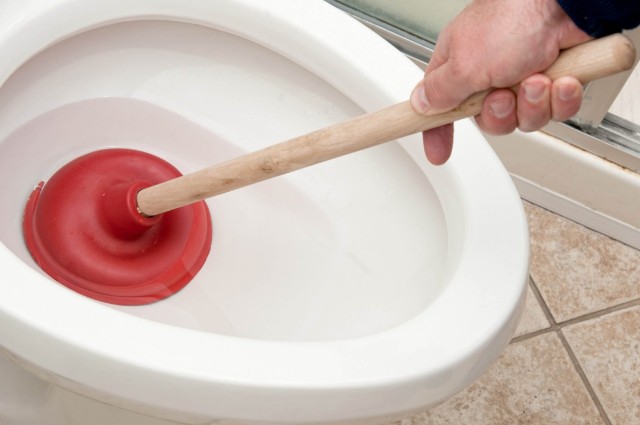How to Unblock a Toilet

Dealing with a blocked toilet? Though it’s never the most pleasant scenario and can be a difficult experience, worry not! Our purpose in being here is to tell you how to unblock a toilet. Saying farewell to that bothersome obstruction will be easy with a dash of expertise and a sprinkling of practical advice.
So, stay with us if you’re prepared to face this typical home issue head-on! We provide all the guidance required to restore your toilet to optimal functioning: Simple fixes, no more worries. Let’s get started and remove that blockage permanently!
How to unblock a toilet with a plunger
Let’s get started on the easy methods to quickly solve this common household issue by utilising a plunger to unblock a badly blocked toilet.
Getting ready
Before you begin, let’s make sure we have everything we need. To avoid any unpleasant situations, start by shutting off the water supply valve and closing the toilet tank flapper. Definitely not what we want is any overflowing accidents! Next, get some old newspapers or towels and arrange them along the base of the toilet to catch any spilt water while we clear the obstruction.
Choosing the proper plunger
Some plungers are better than others, particularly in terms of clearing clogs in toilets. A flange plunger is a distinguished toilet unblocker with its extended rubber flange at the bottom and distinctive design. The tight seal that this flange creates when it fits precisely into the toilet drain is necessary for efficient plunging.
Proper positioning
Now that you have the right plunger, you need to put it in the toilet bowl properly. Place the plunger’s rubber cup in the water, making sure that the flange covers the whole drain opening. Tilt the plunger at an angle to get the optimum seal and suction against the toilet drain.
Applying pressure
Once the plunger is in the desired position, take hold of the handle firmly with both hands and gradually lower it into the water. To release any trapped air in the cup, begin with gentle, steady plunges. After the air has been expelled, push down hard and then draw up strongly to increase the intensity of your plunge. The idea is to generate a powerful water rush that will lift the obstruction.
Checking for success
After a few plunging attempts, it’s time to see if the blockage has cleared. Flush the toilet and see how the water flows. If it drains away freely without backing up, well done – you’ve successfully unblocked the toilet! But if the water level remains high or drains slowly, it may mean the blockage is still there, so keep plunging.
Persistence and patience
Some blockages might need a bit more effort to clear. Don’t worry if it’s not cleared right away – keep plunging, switching between gentle and forceful motions until the obstruction is fully cleared and the toilet flushes smoothly.
How to unblock a toilet using hot water
Another useful technique that is great in some circumstances is using water. To begin, use your electric kettle or a pot on the stove to bring water to a boil. The water should be extremely warm, about the temperature you’d use for a decent cup of tea – not scorching hot.
Pour the hot water into the toilet bowl carefully, starting at waist height. The goal is to provide some pressure in order to push the obstruction to separate and go further. After adding the hot water, allow it a few minutes to do its job. Any recalcitrant obstructions will get softer through the heat and become easier to remove.
Check to see if the obstruction has cleared by flushing the toilet after letting the hot water do its magic. Hopefully, you’ve successfully unblocked your toilet with hot water if the water drains away smoothly.
A single hot water cycle may not always be sufficient to completely dissolve the obstruction. Don’t worry if, after the first attempt, the water still won’t drain correctly; just keep trying until the blockage is removed.
Although using hot water to unclog toilets can work, caution is advised. The porcelain in the toilet bowl could be cracked, so be careful not to pour boiling water into it directly. Always use hot water that’s just warm enough to touch without becoming scorching.
Unblock the toilet using a drain auger
An auger for drains, often known as a plumber’s snake, can be a real lifesaver in the case of really stubborn clogs that refuse to go away.
Push the auger firmly and gently into the toilet drain until you encounter resistance. This is where the obstruction is hiding, so prepare to use your magic here. Turn the auger handle clockwise to begin. As it passes through the obstruction and splits it apart, the coiled wire at the end will twist and turn, opening the way.
Until you feel the resistance reduce, keep turning the lever and pushing the auger farther down the drain. This indicates that you are moving forward and coming nearer to removing the obstruction. After pushing the auger as far as it will go, carefully pull it back from the drain, being careful to gather any loose material. Try flushing the toilet to see whether the clog has been removed.
Unblock your toilet with baking soda and vinegar
Let’s now explore a quick, non-toxic way to unclog your toilet! All you actually need is vinegar and baking soda, which you probably already have in your kitchen cabinet. When mixed, they undergo a chemical reaction that may help loosen and remove the obstruction in your toilet. It resembles a tiny scientific experiment that you may do in your bathroom!
Start by evenly dispersing one cup of baking soda over the whole surface of the toilet bowl. Next, slowly add an equal amount of vinegar. You will notice them begin to foam and bubble up as soon as they come together. As they work to remove the obstruction, that is the magic that takes place. Give the mixture an hour or, for best results, overnight to sit in the bowl. They have plenty of time to perform their magic and unclog the drain because of this.
Give it some time, then flush the toilet to check if the obstruction has cleared. Should it persist, you may wish to repeat the procedure. This technique also works unblocking sinks.
Using washing-up liquid to unblock a toilet
A very good method of unclogging a toilet without the need for a plunger is to use dishwashing liquid, especially if the obstruction is only partially blocked or results from grease or organic waste. Fill the toilet bowl with a sufficient amount of washing liquid – roughly half to one cup. This soap helps to dissolve oil and remove obstructions.
Add around one bucket’s worth of hot water to the dishwashing liquid. Let the soap and hot water mixture soak in the toilet bowl for ten to fifteen minutes, minimum. This allows the soap enough time to efficiently dissolve the obstruction.
After plunging, flush the toilet to see if the blockage has cleared and if the water drains correctly.
Use a coat hanger when unblocking a toilet
Take a wire coat hanger, or better yet, one coated in plastic, and try this method. Without scratching your toilet, these hangers are simple to bend into form. But don’t worry if all you have on hand is a simple wire hanger! To keep your toilet secure, simply wrap it up with some tape or an old cloth.
Insert the makeshift instrument into the drain and manoeuvre it to remove the clog. If you feel the obstruction, push against it, and if you are lucky, you will see the water starting to drain properly. On the other hand, you might find it difficult to reach a blockage using this method. This means that the stoppage is further down the drain.
Use a wet-dry vacuum cleaner to unclog a toilet
It is possible to resolve a difficult toilet blockage by employing a wet-dry Hoover cleaner. Try it with one if you have one that is meant to handle water. First, make sure you properly dispose of the water in the toilet bowl by using the Hoover to remove it. After emptying the bowl, insert the Hoover hose into the U-bend and slide it down the toilet. Secure the toilet bowl to the Hoover tube by wrapping a cloth around it to complete the transaction. In this manner, the hoover may have just enough suction to remove that bothersome obstruction.
Unclog a toilet using commercial products
If all else fails, you might attempt unblocking a toilet with a commercial toilet unblocker or by calling a plumber. They have liquefying material certification. This only functions if there’s no hard item causing the obstruction. Chemical-based and enzyme-based drain cleaners are the two possibilities. Both your drains and the environment are safer when using enzyme products. Since chemical drain cleaners are frequently poisonous, make sure you follow the directions on the package if you decide to use one to unclog your toilet.
Disclaimer: These products are not suitable for septic tanks. There are certain septic-safe drain cleaners on the market that would prevent system damage.
How do I know the toilet Is blocked?
In the case that you recognise any of these warning signs, you should act quickly to avoid more plumbing issues. It is advisable to address a clogged toilet as soon as possible because waiting will just result in more severe problems later on.
- Slow draining – If you flush the toilet and see that the water in the bowl takes a while to drain, there may be a blockage in the drainage line.
- High water level – The water level in the bowl rising much above its usual level after a flush is another clue. There’s a good chance there’s something blocking the flow if the lavatory seems ready to welcome an aquatic extravaganza.
- Gurgling noises – Have you ever heard strange sounds like gurgling or bubbling sounds coming from the bathroom while you’re flushing? It’s like trying to say something out loud. It says, “Look, there’s something strange underneath!” These noises usually indicate that air is trapped around a barrier, which is what caused the problem.
- Nasty smells – A clogged toilet can quickly turn into a smell-fest. Even after cleaning, if foul odours are detected coming from the bathroom, it could indicate an imminent blockage.
- Backflow – Occasionally, a clogged toilet may set off a series of issues that prevent other fixtures in the house from draining properly. Following a bathroom flush, delayed draining in sinks or showers could indicate a more serious clog in the plumbing system.
- Observable obstruction – Sometimes, the evidence is so obvious that it is almost impossible to miss. Focus your attention down the toilet drain and check for any obvious obstructions like too much tissue paper or mysterious objects hidden there.
If you are having trouble identifying the type of blockage, call a plumber to deal with your badly blocked toilet in London.
Note: A blockage in a toilet macerator or waste outlet needs diagnosing the root of the problem and application of unblocking methods different from those used for standard toilets. Your best bet is to contact a Saniflo plumber who will help you remove the blockage hassle-free way.
Why does the toilet keep blocking?
Your toilet might throw a blockage party for a few reasons:
- Excessive flushing – Sometimes, we get a bit trigger-happy with the flush button. Too much toilet paper or flushing down items that shouldn’t go down there (like wipes or sanitary products) can create a blockage.
- Build-up of waste and debris – Think of it like a traffic jam in your plumbing system. Over time, debris and grease can build up in the pipes, blocking them and slowing the flow.
- Hard water deposits – Do you live somewhere with hard water? These mineral deposits can cause havoc on your toilet pipes by obstructing the flow of water and making blockages easier to happen.
- Tree root intrusions – The small surprise of nature: tree roots that get into your subterranean pipes can create havoc and harm, eventually clogging them up.
- Faulty plumbing design – Your plumbing can sometimes be the problem, not you. Blockages may be more likely to surface in old or improperly installed pipelines.
- Low water pressure – Blockages may occur when waste is not effectively pushed down the pipes by a weak flushing mechanism in your toilet.
- Foreign objects – Ahh, the age-old error, inadvertently flushing down items like jewels or toys that have no business being in the toilet. It can happen to the best among us!
How to prevent toilet clogs
- When opposed to the aftermath, preventing toilet clogs is a breeze. To keep your toilet functioning properly, consider the following helpful advice:
- Keeping your toilet squeaky clean is key to keeping limescale at bay. It’s a simple trick to stop those pesky blockages from catching you off guard.
- Be mindful of what you’re flushing. Stick to the basics like human waste and toilet paper. Avoid sending down non-flushable items like cotton balls or wipes – they’re not friends with your plumbing system and could cause some serious damage.
- Steer clear of dumping large wads of paper down the drain at once. Do not forget that modest amounts work wonders!
- Keep an eye out for any leftover bits and bobs from repairs or renovations that could accidentally find their way into your toilet. You don’t want them causing blockages later on!
- Make additional effort to keep toys and other temptations away from the toilet if you have children running around. Kids may be extremely curious, as we all know!
- Consider adopting a “lid down” rule to prevent any accidental drops of items like shampoos or toys into the toilet. It’s a simple step to avoid potential mishaps.
- Save your snacks for the kitchen – food has no place in the loo! Toss any leftovers in the bin instead of risking a flush that could lead to trouble.
- Get a water softener if you’re finding it difficult to deal with hard water. It’s similar to giving your water a mini spa treatment; it keeps limescale at bay and lessens the likelihood that those annoying obstructions will cause you problems.
Trying it all, and your toilet still keeps blocking? Maybe it’s time to consider emergency plumbing services before any expensive damages occur.
Conclusion
There you have it – a useful how-to for clearing that annoying clogged toilet! Equipped with these practical advice and methods, you’re prepared to take on this typical domestic annoyance head-on. Remember that perseverance pays dividends, so if his blockage fails to clear straight away, don’t give up. Every toilet problem has an answer, whether you choose the reliable plunger or the conjuring power of baking soda and vinegar.
But remember one important lesson: prevention is vital! You may prevent future blockages and maintain the smooth operation of your toilet by taking easy precautions, such as being mindful of what you flush and keeping an eye out for the little troublemakers at home.
So, do not be alarmed next time you encounter an obstinate blockage! You can quickly get your toilet operating again with a little knowledge and perseverance. Happy plunging!
How to Unblock a Toilet
Need help? Hire the London Property Service experts today by giving us a call on 020 3078 5920.




